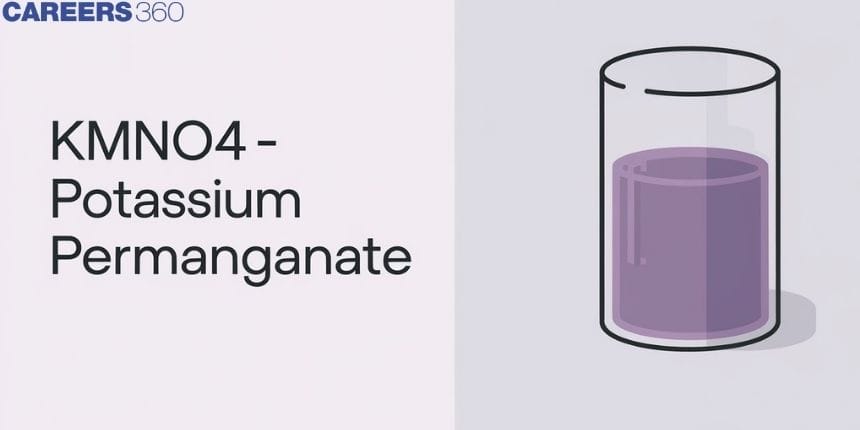KMnO4 (Potassium Permanganate): Uses, Structure, Preparation, Properties
Potassium permanganate is an odorless and purple to magenta crystalline solid. KMnO4 is soluble in water, acetone, acetic acid, methanol, and pyridine. It easily dissolves in ethanol and organic solvents. Potassium permanganate is in the form of monoclinic prisms that is almost opaque with a blue metallic luster. When potassium permanganate crystals are dissolved in water the solution formed is purple. It is considered as a strong oxidizing agent and does not produce toxic by-products.
This Story also Contains
- KMnO4 - Potassium Permanganate
- Some Solved Examples
- Conclusion

Potassium permanganate is commercially prepared by mixing KOH and powdered manganese oxide, with oxidizing agents like potassium chlorate. The mixture is boiled and evaporated and the residue is heated in iron pans until it has acquired a pasty consistency. The potassium manganate (green) so formed is boiled with a large quantity of water and a current of chlorine CO2 and ozonized air is passed into the liquid until it is converted into permanganate. The MnO2 formed is removed continuously in order to prevent its breaking down the permanganate.
KMnO4 - Potassium Permanganate
Potassium permanganate is prepared by the fusion of MnO2 with an alkali metal hydroxide and an oxidizing agent like KNO3. This produces the dark green K2MnO4 which disproportionates in a neutral or acidic solution to give permanganate.
Commercially it is prepared by the alkaline oxidative fusion of MnO2 followed by the electrolytic oxidation of manganate (Vl).
In the laboratory, manganese (II) ion salt is oxidized by peroxodisulphate to permanganate.
Potassium permanganate forms dark purple (almost black) crystals which are isostructural with those of KClO4. The salt is not very soluble in water (6.4 g/100 g of water at 293 K), but when heated it decomposes at 513 K.
It has two physical properties of considerable interest: its intense color and its diamagnetism along with temperature-dependent weak paramagnetism. These can be explained by the use of molecular orbital theory which is beyond the present scope.
The manganate and permanganate ions are tetrahedral; the π-bonding takes place by an overlap of the p orbitals of oxygen with the d orbitals of manganese. The green manganate is paramagnetic because of one unpaired electron but the permanganate is diamagnetic due to the absence of unpaired electron.
A few important oxidizing reactions of KMnO4 are given below:
(1) In acidic solutions:
- Iodine is liberated from potassium iodide:
- Fe2+ ion (green) is converted to Fe3+ (yellow):
(2) In neutral or faintly alkaline solutions:
- A notable reaction is the oxidation of iodide to iodate:
- Thiosulphate is oxidized almost quantitatively to sulfate:
Recommended topic video on (KMnO4 (Potassium Permanganate))
Some Solved Examples
Q.1 If
(1) 4 to 2
(2) 6 to 4
(3) 7 to 2
(4) 7 to 4
Solution:
As we learned -
Oxalic acid reacts with acidified
So, the oxidation state of Manganese changes from +7 to +2.
Hence, the answer is the option (3).
Q.2 Consider the following reactions:
The sum of the total number of atoms in one molecule each of A, B, and C is:
(1) 18
(2) 16
(3) 14
(4) 20
Solution:
As we learned -
(A) = CrO2Cl2
(B) = Na2CrO4
(C) = CrO5
Total atoms = 5 (A) + 7 (B) + 6 (C) = 18 atoms
Hence, the answer is the option(1).
Conclusion
There are wide applications of KMnO4. Some important uses of potassium permanganate are used in qualitative analysis to determine permanganate value. It is also used as a regeneration chemical in well water treatment for the removal of hydrogen sulfide and iron. This compound is used as a disinfectant to cure certain skin conditions like foot fungal infections, and dermatitis. The antibacterial action of KMnO4 is dependent on the oxidation of proteins of bacteria or tissues by this compound.